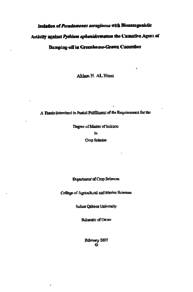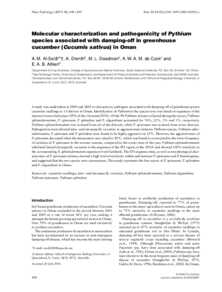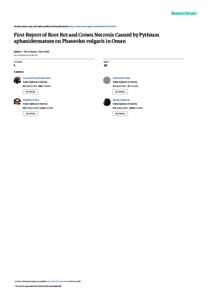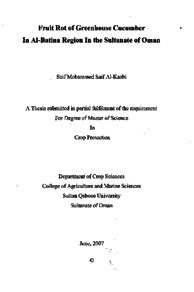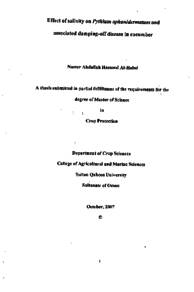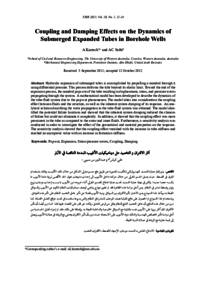Document
Isolation of Pseudomonas Aeruginosa with bioantagonistic activity against Pythium Aphanidermatum the causative agent of damping-off in greenhouse-grown cucumber
Publisher
Sultan Qaboos University
Gregorian
2007
Language
English
Subject
English abstract
Damping-off disease was characterized as the most destructive disease in greenhouse cucumber in the Sultanate of Oman. Economically, the disease causes a great loss in cucumber production. The current study was conducted mainly to evaluate potential biological alternatives to chemical fungicides for the control of Pythium damping-off disease by the mean of antagonistic bacteria. It was carried out in two experiments. The purpose of the first study was to illustrate factors influencing growth of Pythium aphanidermatum (P085); causal agent of damping off. Radial growth rate of P. aphanidermatum was evaluated under three varying
environmental factors: temperature (35, 30, 25, and 20°C), soil water content (19.88, 18.30, 16.67%), and salinity (0.0252, 2.44, 5.97, 12.03 ds/ m and 0.0124 ds/ m was included as a control). Sand growth assay was used to evaluate fungus growth rate A temperature of 35oC significantly increased the radial growth rate of P. aphanidermatum (0.59 mm/hr). The highest level of water content (19.88%) showed an increase in expansion rate of the fungus. The growth rate at this water level was 0.68mm/hr. No correlation was found between radial growth rate of the fungus and salinity level. The maximum growth rate was observed when applied water was 20 ml (19.88%) at 35°C.
The second study was conducted to evaluate the potential of twenty one isolates of Pseudomonas aeruginosa strains to suppress Pythium aphanidermatum inducing cucumber damping-off. Paper disk assays were used to assess bacterial antagonism in vitro. Bacterial growth and activity were evaluated under different temperatures and levels of salinity. A bioassay demonstrating suppression of damping-off of cucumber seedlings was done under greenhouse conditions. Seven isolates were superior in inhibiting radial growth of P. aphanidermatum on PDA. Bacterial isolates showed optimal growth at 30°C, whereas a temperature of 37°C favored bacterial antagonistic activity. Bacterial growth was inhibited at 12.03 ds/m for the seven isolates. All the selected isolates enhanced the growth of cucumber seedlings (height, fresh weight, root length, root weight and number of leaves). Isolates 7,38, 48, 49, 94 and 95 appeared to have potential to control damping-off disease.
Member of
Resource URL
Arabic abstract
يعتبر مرض الذبول الفجائي من أكثر الأمراض اضرارا بمحصول الخيار في البيوت المحمية في سلطنة عمان. حيث يسبب المرض خسائر اقتصادية كبيرة في انتاجية الخيار. تم اجراء هذه الدراسة بصفة رئيسية لتقييم البدائل البيولوجية المحتملة المبيدات الفطرية الكيميائية لمكافحة مرض الذبول الفجائي للبيئيم باستخدام البكتيريا المضادة. شملت الدراسة نوعين من التجارب. وكان الهدف من الدراسة الأولى توضيح العوامل التي تؤثر على نمو فطر البيژيم P085 ( Pythium aphanidermatum ) العامل المسبب لمرض الذيول. تم تقديم معدل النمو الصوفي للفطر تحت ثلاثة عوامل بيئة مختلفة هي: درجة الحرارة ( 20، 25، ، 30 و 35 درجة حرارة مئوية)، ومستوى الماء في التربية ( 16. 67 ، 30 . 18 ، 88 . 19 %) ودرجة التملح (0.0252، 2.44, 5.97 ، 12.3) ديسيس منز لكل متر ، كما تم استخدام 0.0124 معدل كضابط. تم استخدام طريقة النمو الرملي لتحديد معدل سرعة نمو الفطر. زادت درجة الحرارة 35 مئوية من معدل النمو القطري للفطر ( 0.59 مم / الساعة). كما كان أعلى معدل زيادة في نمو الفطر عند مستوى 19.88 % للماء في التربة حيث كان معدل معدل النمو عند هذا المستوى 0.68 مم / الساعة. كما أظهرت الدراسة عدم وجود ارتباط بین معدل النمو القطري الفطر مع درجة التملح. ثبت أيضا أن أعلى معدل نمو الفطر كان عند مستوى مياه 20مل ( 19.88%) و درجة حرارة 35 مئوية. تم اجراء الدراسة الثانية لتقديم القدرة التثبيطية ل.21 عزلة من بكتيريا (Pseudomonas aeruginosa) ضد فطر (Pythium aphanidermatum). تم استخدام طريقة القرص الورقي للتقييم مدى تضادية البكتيريا في المختبر. تم تقديم نمو و نشاط البكتيريا تحت مستويات مختلفة من الحرارة و الملوحة. تم استخدام التققيم الحيوي لقياس مدى قدرة عزلات البكتريا من ة تثبيط مرض الذيول الفجائي في شتلات الخيار تحت ظروف البيوت المحمية. وجد أن سبع عزلات من البكتيريا كان لها القدرة في تثبيط نمو الفطر (Pythium aphanidermatum) في الوسط الغذائي (PDA). وكما لوحظ أن أفضل نمو البكتيريا كان عند 30 درجة مئوية ، بينما كانت درجة الحرارة 37 درجة مئوية أكثر ملاءمة للنشاط التضادي للبكتيريا. أظهرت النتائج توقف النمو البكتيري السبع العزلات عند مستوى ملوحة 12.03ديسس منز. ساعدت السبع. العزلات في تحسين نمو شتلات الخيار ( الطول، الوزن الطازج، طول الجذور، وزن الجذور، و عدد الأوراق). وجد أن العزلات رقم 7، 38، 48، 49، 94 و 95 لها القدرة في مكافحة الفطر المسبب لمرض الذبول الفجائي (Pythium aphanidermatum) في الخيار.
Category
Theses and Dissertations

